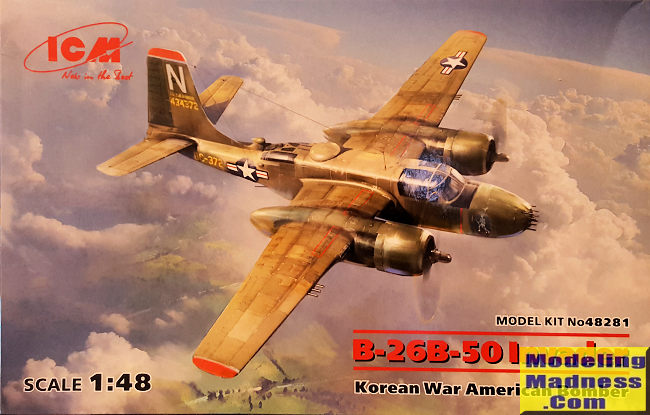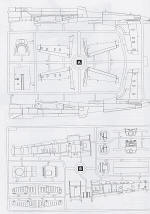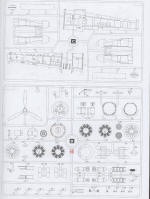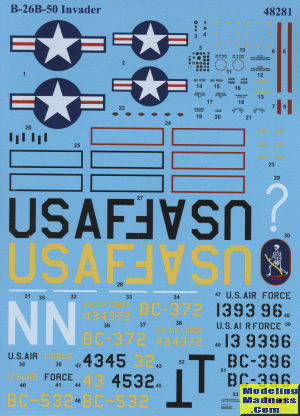
ICM 1/48 B-26B-50 Invader
| KIT #: | 48281 |
| PRICE: | around $60.00 |
| DECALS: | Three options |
| REVIEWER: | Scott Van Aken |
| NOTES: | 2019 tooling |

| HISTORY |
B-26 Invaders of the 3d Bombardment Group, operating from bases in southern Japan, were among the first USAF aircraft engaged in the Korean War, carrying out missions over South Korea on 27 and 28 June, before carrying out the first USAF bombing mission on North Korea on 29 June 1950, when they bombed an airfield outside of Pyongyang.On 10 August 1950, the Air Force Reserve's 452d Bombardment Wing was activated for Korean service. It flew its first missions in November 1950 from Itazuke, Japan, providing daylight support, with the 3rd Bomb Wing, consisting of the 8th, 13th and 90th Bomb Squadrons, flying night missions. Because of the Chinese intervention, it was forced to find another base and moved to Miho Air Base on the west coast of Honshū. In early 1951 it moved to Pusan East (K-9) Air Base and continued its daylight as well as night intruder missions. In June 1951, it joined the 3rd Bomb Wing (Kunsan (K-8)) in night activity only, dividing the target areas, with the 452nd taking the eastern half and the 3rd the western. For its efforts in the Korean War, it was awarded two unit citations and the Korean Presidential Citation. It also received credit for eight campaign operations.
In May 1952 it was inactivated and all of its aircraft and equipment along with its regular air force personnel were absorbed by the 17th Bomb Wing. During its time as an active unit, the 452nd flew 15,000 sorties (7000 at night) with a loss of 85 crewmen.
B-26s were credited with the destruction of 38,500 vehicles, 406 locomotives, 3,700 railway trucks, and seven enemy aircraft on the ground. On 14 September 1951, Captain John S. Walmsley, Jr. attacked a supply train. When his guns jammed, he illuminated the target with his searchlight to enable his wingmen to destroy the train. Walmsley was shot down and posthumously awarded the Medal of Honor. Invaders carried out the last USAF bombing mission of the war 24 minutes before the Armistice Agreement was signed on 27 June 1953.
In addition to the standard attack versions of the B-26 which flew night interdiction missions, a small number of modified WB-26s and RB-26s of the 67th Tactical Reconnaissance Wing flew critical weather observation and reconnaissance missions in supporting roles.
| THE KIT |


 This
kit was released late last year and has gotten fairly good press. There are
always those who want a new tool kit even if the older one is still quite nice
and so here we have a replacement to the Monogram boxing. The major benefit of
this kit is the engraved panel lines and slightly greater detail. Those who have
built it have opined that it was an easier build.
This
kit was released late last year and has gotten fairly good press. There are
always those who want a new tool kit even if the older one is still quite nice
and so here we have a replacement to the Monogram boxing. The major benefit of
this kit is the engraved panel lines and slightly greater detail. Those who have
built it have opined that it was an easier build.
As far as I know, this has been released in two boxings. This Korean War gun nose version, and an earlier WWII gun nose version. I have to assume that there will be separate boxings for the glass nose variants.
As mentioned, the tooling is very good on this one. You get a fairly complete cockpit and a nicely detailed bomb bay. Those who model this with the doors closed can simply leave off all the bomb bay bits as they will not be seen. You will, however, need to put in the various bulkheads for proper fuselage stiffness.
There are separate control surfaces and it appears that all are designed to be installed in the neutral position. An interesting part of the instructions is that the flight surfaces are to be attached to the fuselage before installing the nacelles. All of the gear doors are integral with the inner gear wells so you have to install them during the build of these areas. However, the gear themselves can be left off until after painting. Note that with the wings one needs to pick their ordance selection prior to assembly in order to open the various holes. You get the following things to put under wings; fuel tanks, gun pods, bombs. Two of each. Check your photo references to see what was actually carried.
There are both upper and lower turrets provided as well as a nicely detailed
gunsight station. Often Korean War B-26s did not have these turr ets
installed. It would have been nice to have that option, but perhaps another
boxing will provide that. If not, the
aftermarket crowd will be sure to take care of that issue. Engines and landing
gear are nicely detailed and with a bit of effort, the engines can look superb.
ets
installed. It would have been nice to have that option, but perhaps another
boxing will provide that. If not, the
aftermarket crowd will be sure to take care of that issue. Engines and landing
gear are nicely detailed and with a bit of effort, the engines can look superb.
Instructions are well done with Revell and Tamiya paint references. There are three options. One is in unpainted metal with yellow trim with the 8th BS/3 BG based at Iwakuni in 1951. The box art lane is in OD over neutral grey with the 13 BS/3 BG also at Iwakuni, but in 1950. It has red trim. Finally an overall OK plane with an unpainted metal fin and yellow trim from the 730 BS at Miho in 1950. Decals are nicely printed and should work fine. There are some older decal options for the ProModeler kit that might work with this and I'm sure we will be seeing others in the near future.
| CONCLUSIONS |
Tom Cleaver built this kit a few months back and he was pleased with the result. This won't be a rapid build for most of us, but the end results should be superb. What's best is that there is all that nose to fill with weight as you'll need it. Instructions recommend 40 grams
| REFERENCES |
https://en.wikipedia.org/wiki/Douglas_A-26_Invader
Thanks to for the review kit. You can find this kit at your favorite
hobby shop or on-line retailer.
If you would like your product reviewed fairly and fairly
quickly, please
contact
the editor
or see other details in the
Note to
Contributors.
Back to the Main Page
Back to the Review Index Page
Back to the Previews Index Page